Quick answer: The best option to fix a commercial roof without replacing it is to install a spray foam roof or a silicone roof coating system. Determining which one depends on current roof conditions and what roofing system is currently installed.
So, you have an older roof, and you want it renewed. You know a complete tear-off is always an option, but how much will that cost?
A lot!
Several questions arise when talking about roof renewal; here are some:
- Why is replacing your roof so bad? [it’s more than just cost]
- Does the number of existing roofing systems matter?
- Is there an R-value that is desired?
- What’s the best option based on the existing roofing system?
For example, the best option for a single-ply roof may not be the best option for a metal roof.
In this article, we’ll answer all those questions, review each commercial roofing system, and explain the best option to renew these without replacing the existing roof.
And just so you’re aware, West Roofing Systems has been in commercial roofing since 1979. We’ve seen every roofing system out there. We’ve competed against total replacements, repair-only quotes, and roof renewals.
Let’s get started!
Why is roof replacement a bad thing?
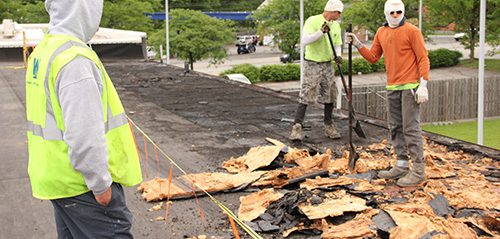
Cost
It costs money in labor to remove the existing roof and bag/secure it. It costs money to transport all those materials to a landfill. And there are landfill costs depending on how much weight you’re contributing.
Business interruption
When you remove an entire roof versus restoring or renewing, the roofing contractor will take longer to complete the job. This means they will be on your facility taking up parking spots, shutting down HVAC units, walking into your building, and using up the maintenance person’s time.
They will have safety setup lines everywhere and designated walkways. They might even block off entrances into your facility or recommend your employees park in a different parking lot.
Bad for the environment
Roof replacement adds the most possible amount of materials to landfills, simple as that. One issue we’ve encountered is a building owner with a roof that’s 75% good but still opts to remove and replace 100% of it.
WHY WOULD YOU DO THAT???
Why not remove and replace the 25%, then add a roofing system over the top of everything, getting you a new warranty?
Does the number of existing roofing systems matter?
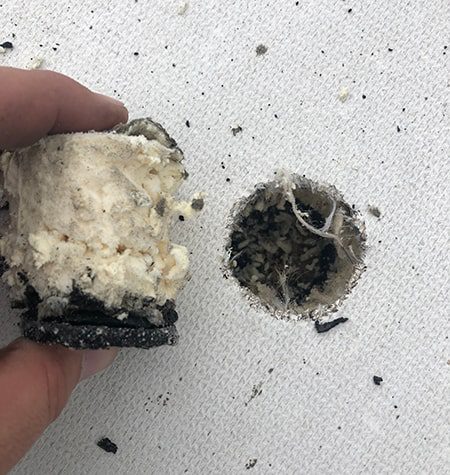
Yes.
If you have one roofing system installed, you can do whatever you like. Per building code, the maximum number of roofing systems you can have installed is two.
You can add a roofing system over what you already have or do a complete replacement.
If you have two roofing systems installed, you cannot add a 3rd. The best option, in this case, is to install a silicone roof system over what you already have. Roof coating systems do not count as an official “roofing system” under building codes.
Sometimes the first roof is in good shape, but the second is not. Removing the entire 2nd roofing system frees you up to install any roofing system you’d like.
Does a desired R-value matter?
Yes.
Silicone roof coating systems do not add any significant R-value. Per manufacturer product data sheets, they have less than an R-1.
White/grey colored coatings can add reflectivity from the sun, reducing the temperature of your roof, but that won’t reduce your energy bills as much as adding R-value.
Spray polyurethane foam has an R-value of 6.5 per inch of thickness. Add two inches, add an R-13 to the R-value you already have.
Now let’s get into each roofing system and see the best option to fix them instead of a complete replacement.
The best option to avoid a replacement for a single-ply roofing system
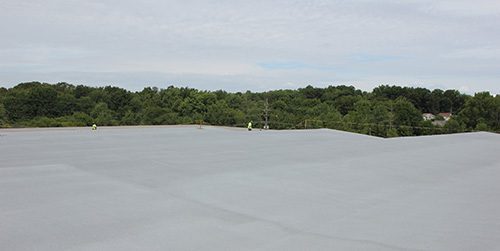
The best option is to install a spray foam roofing system or a silicone roof coating system. This depends if the roof is in good or bad condition.
If the roof is in good shape, like:
- 25% or less of the entire roof’s insulation is wet
- The seams are in good shape [there’s good adhesion and it’s definitely not completely ripped open]
- There’s been at least annual maintenance
Then the best option is to install a silicone roof coating system.
A contractor can perform an adhesion test to ensure the coating sticks properly.
They will then clean the roof. Then they will reinforce the seams by laying down coating, installing a mesh into that coating, and then covering the mesh with more coating. This is called “seam reinforcement.”
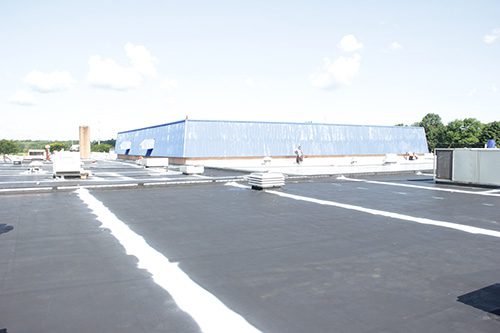
Then a contractor will install the proper amount of coating to get the desired warranty.
- For a 10-year warranty, 20 mils of coating are installed to the field of the roof.
- For a 15-year warranty, 25 mils of coating are installed to the field of the roof.
- For a 20-year warranty, 30 mils of coating are installed to the field of the roof.
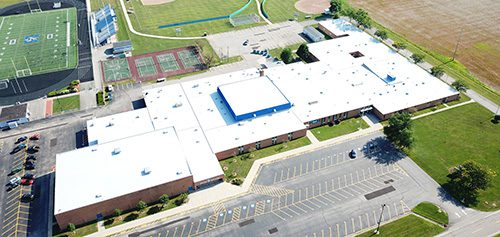
If the roof is in poor shape (for example, the seams are ripped open), the best option is to install a spray foam roofing system. The contractor will:
- Identify the areas with wet insulation (through core samples or infrared inspection)
- Remove and replace only those areas with similar material
- Lay a coverboard over the existing roof (this gives spray foam the best possible adhesion)
- Then spray foam over the entire roof
Installing a spray foam roof minimizes tear-off. It also adds to the R-value you already have. Plus, they are renewable, installed quickly (because they are fluid-applied and easily go around pipes, drains, HVAC units, etc.), and have the same warranty as roof coating systems.
The best option to avoid a replacement for a metal roof
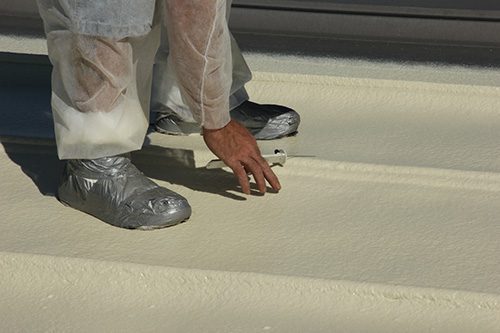
Metal roofs are the most expensive to replace. You want to avoid replacing them as much as possible. Metal is the heaviest roofing system, making removal difficult and paying the most in landfill fees.
And the new metal roof will be super expensive as well.
The best option to avoid a replacement is exactly the same as a single-ply roof.
Install a coating system if it’s in good shape. Install a spray foam roof if it isn’t.
Note: If R-value is important, your best option is to install a spray foam roof. Even if a coating system may be more cost-effective on the install price, you won’t gain any R-value. Remember, even if you choose the lowest length of warranty (10 years), 120 monthly energy bills will still occur.
The best option to avoid a replacement for a ballasted roof
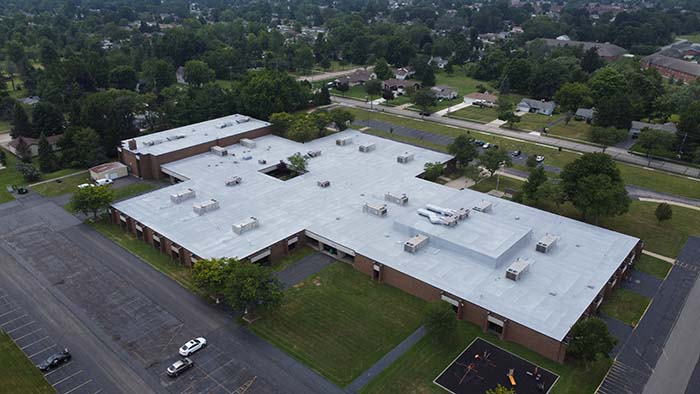
The best option to prevent a replacement for a ballasted roof is to install a spray foam roof.
Roof coating systems aren’t a good option because when you remove the ballast (or loose rocks), crevices will be left in the membrane, leaving an unsmooth surface behind.
It would take an extraordinary amount of coating to fill in all the crevices and install a consistent thickness that grants a warranty.
Spray foam is the best option.
A contractor can remove the ballast by hiring a wet-vac company. They will essentially vacuum the loose rocks off the roof. The contractor will then seek out wet insulation. If there’s any wet insulation, they will remove and replace only those areas.
Once that’s complete, the roof is power-washed, allowed time to dry, and then spray foam is installed over the entire roof.
NOTE: Ballasted roofs can have multiple substrates beneath them. Common names are built-up or modified roofs. A gravel-built-up roof is another popular name. If rocks are on top, they will push down and create a “grainy” surface. “Grainy” is no good for coating systems, but perfect for spray foam.
The best option to avoid a replacement for a smooth built-up roof
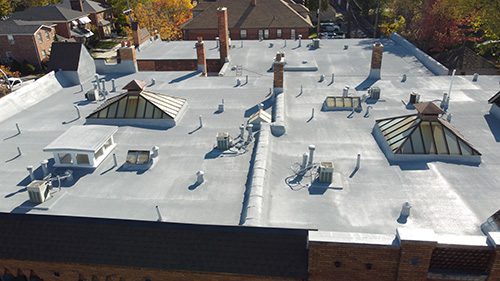
Since the top layer of the roof is smooth, your best option is to install a coating system or a spray foam roof.
Again, good condition; the cheaper option will be coating. The more expensive option will be spray foam, but you get the added R-value, 1-2” thick membrane, and future energy savings.
It’s highly recommended to get quotes for both systems.
Conclusion
If there’s one thing to take away from this article, it’s that commercial roof replacement isn’t cost-effective.
If it’s your only option because the roof is in such poor shape (for example, 75% of the roof has wet insulation), so be it.
After tear-off, you’d then want to install a coating system or spray foam roof because they are renewable.
This means when the warranty ends, the roof can be cleaned, and more coating can be installed over what’s already there. No more roof removal!
If you aren’t sure if your roof is eligible to be renewed, contact a roofing contractor. Know the health of the seams (if any) and find out the percentage of the roof’s insulation that’s wet/saturated.
In most cases, if the seams are in poor shape, the roof has been neglected for years, and more than 25% of the roof’s insulation is wet, a complete tear-off will likely be recommended.


